Once upon a time, every type of food preparation that required heat or flame took place on open hearths until the first stove debuted in the late 18th century.

Who invented it? Benjamin Thompson (aka Count Rumford) whose idea to come up with a scientifically controlled heating appliance was introduced in the 1790s.
Coal and iron mining in the 1820s proved ideal raw materials to craft appliances capable of dealing with extreme temperature swings and while early metal stoves made in England and Holland were considered the most stylish and versatile by the 1840s, boxy units became the international standard design that remains so to this day.
In this article we will discuss and describe various popular types of Stoves and Ovens for your kitchen, but first let’s explain the difference between a Stove and an Oven:
Stove vs. Oven – What’s the difference?
While the terms are used interchangeably, according to the Maytag appliance website, differences are extreme.
Ovens are enclosed cavities used for baking and roasting within a closed compartment while stove tops – sometimes called cook tops– are open, flat surfaces that heat up pots, pans and other vessels that don’t require a closed environment to fry, boil, sauté, steam and otherwise prepare foods.
Now, here are the main types of Stoves and Ovens to get a better idea of the options you have for your kitchen. Let’s start by the types categorized by the way they operate.
1. Electric stoves
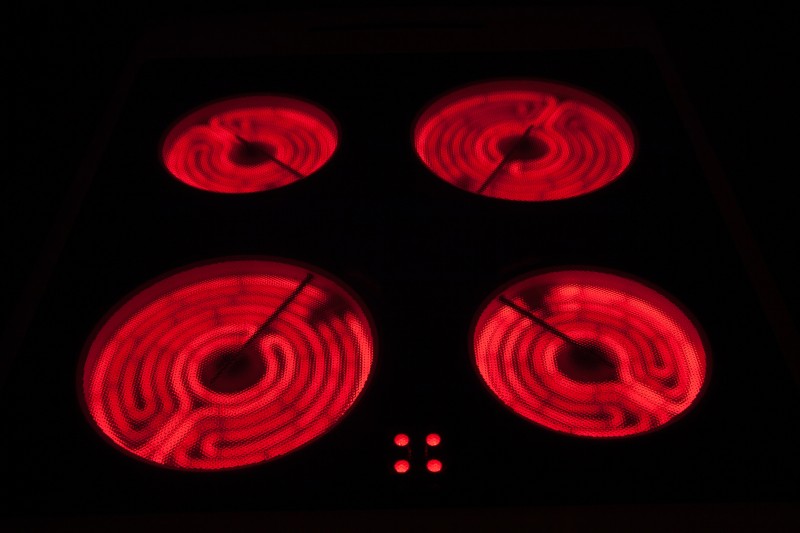
Unlike gas-powered stoves, these units use electric currents rather than flames to activate heating elements that undertake the cooking process.
There are typically four independently controlled burners that deliver “120 volts of alternating current … that travels down each leg” to produce heat, according to Hunker writer Cathy Habas.
When the current flows in the cooking element, heat is produced. While circuitry for all electric stoves is similar, there are differences in the cooking surface.
For example, in ceramic stovetop units the heating element resides under a smooth surface.
2. Gas stoves
Once a natural gas pipeline is run to the kitchen appliance “flame injection multi-torch burners are used” to deliver heat for cooking.
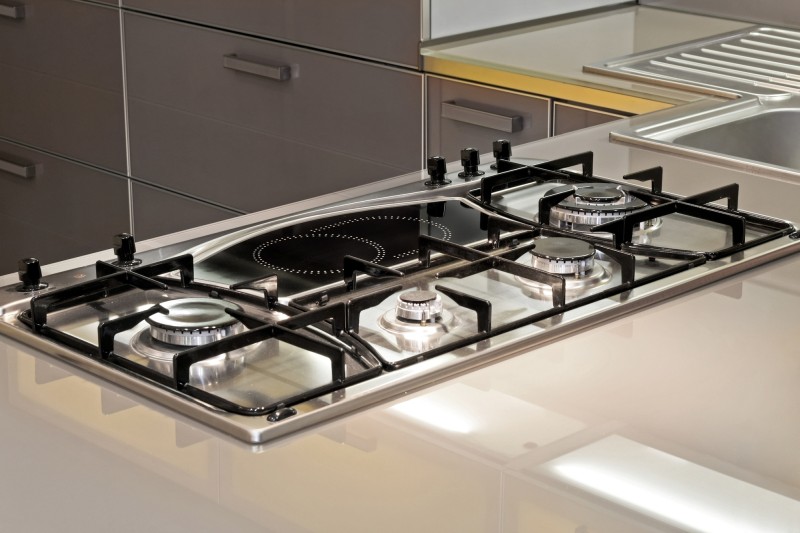
Before it reaches the stovetop, the fuel mixes with air to produce combustion that directs flames to stovetop burners.
All gas stoves require a nozzle, diffuser, and chamber where the gas mixes with the air and the resulting flame is distributed to the steel-encased fire holes that evenly distribute the flame.
3. Induction stoves
“Induction cooking heats a cooking vessel by electrical induction, instead of by thermal conduction from a flame, or an electrical heating element,” according to European manufacturing company CDA.
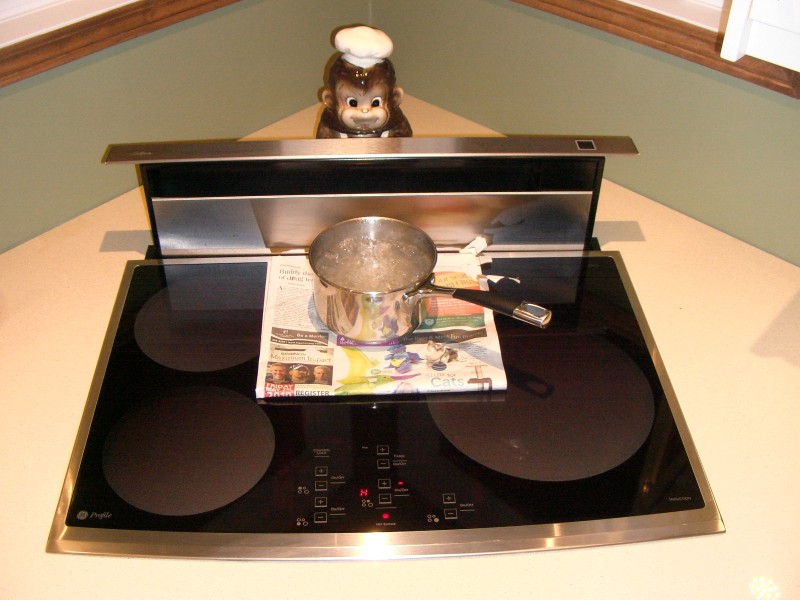
Given this unique method of heating, the pot or pan must be manufactured of cast iron, stainless steel, or another ferromagnetic metal.
Cooking is induced when an induction hob fitted with copper wire beneath the stove’s ceramic plate is powered by an alternating electric current.
As a result, induction stove energy transfer is “around 84% compared to around 74% for gas or ceramic electric.”
Induction stoves are not just energy efficient but considered safer, too.
4. Wood stoves/ovens
Traditional wood stoves may be inefficient and environmentally harmful, but in terms of nostalgia, there is no equal.
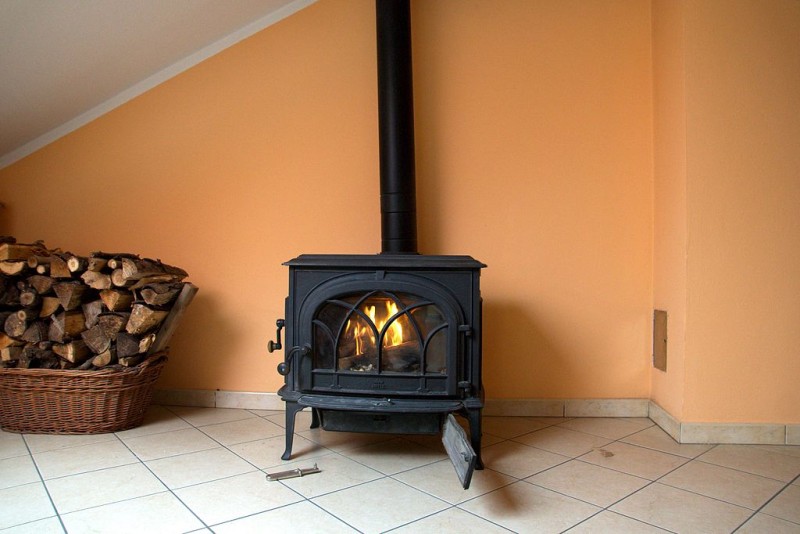
These units rely upon paper, kindling and wood to generate the fire that is aided by fresh air that enters the chamber through intake vents.
While some energy is wasted as the moisture present in logs is burned off and escapes through a chimney with organic gases produced by the flame, these units must reach 1,000 degrees F to generate enough heat to cook foods.
5. Steam ovens
These appliances aren’t for everyone, but in terms of heating capacity, this method of preparing foods dates back as far as 5000 BC.
It’s not difficult to understand how steam ovens work: A water canister installed within the cavity of the unit feeds water into a pump that then converts the water into steam.
Some of these ovens connect to a water line while others require refilling the canister by hand.
By keeping moisture at optimal levels, cooks reduce their dependence upon oils and seasonings while enhancing flavor and eliminating calories.
In sum, this oven produces healthier fare, but since not every manufacturer produces this type of oven, you will likely pay more for one.
6. Pellet stoves
Pellet stoves are favored by people focused on sustainability since they cook foods by burning pellets made of organic materials like wood waste and food.
These densely packed pellets are so tightly compacted, one ton equals about 1.5 cords of firewood, according to reviewers at Home Advisor.
To operate this type of stove, the thermostat is set and a screw releases pellets from a hopper into the firebox. Two fans within the appliance moderate temperature and air exchange as exhaust gasses are vented outdoors.
Stoves/Ovens Categorized by Size:
7. Portable stove/ovens
If you’re looking for something small, compact, and efficient, portable stoves are getting more sophisticated and cheaper.
Some portable stoves are propane-driven while others are butane-powered. Some models offer users both options.
Crafted most often of alloy steel and metal, the most efficient units may not need matches to power them up because ignition mechanisms and propane converter regulators not only take care of that function but aid in switching fuel sources, too.
Safety features include built-in cartridge ejection systems and gas flow cut off mechanisms that eject cartridges if sensors detect irregular pressure while in use.
8. Single oven ranges
The number of single oven ranges currently on the appliance market is truly diverse.
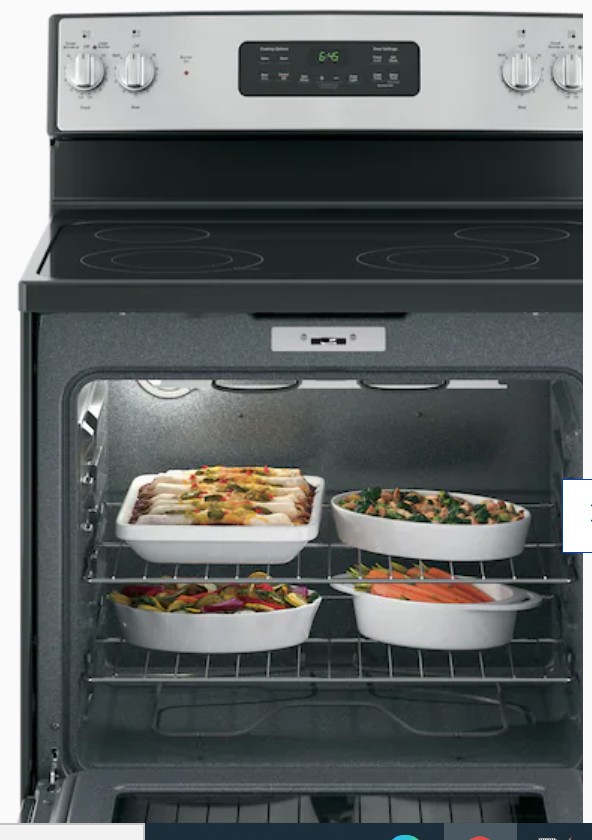
Consumers seeking a no-frills unit capable of producing foods via the self-contained oven and stove top burners find exactly the price point they seek since these units run between $500 and $1700, based upon the number of design and technological features built in.
Further, single oven ranges are produced by top brands, come in myriad finishes and are available as freestanding, slide-in and drop-in models in varying widths, colors and materials.
9. Double oven ranges
More sophisticated, sleek, and offering more capacity, double oven ranges feature stacked compartments so cooks can prepare foods cooked at different temperatures.
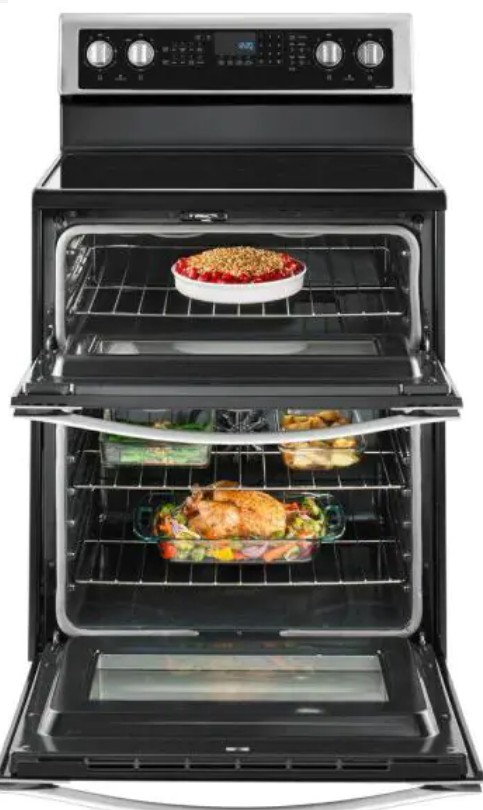
Some of these units feature broilers while others are fitted with convection elements.
Crafted of stainless steel, double oven ranges on today’s market are often classified as smart appliances because they work with IFTTT, Alexa, Google Assistant, and other smart technology.
Both slide-in and freestanding double oven ranges come in popular widths, so shoppers won’t face spacing or installation issues.
10. Double wall ovens
Double wall ovens are pricey but if you don’t need a stove top, they’re an ideal solution.
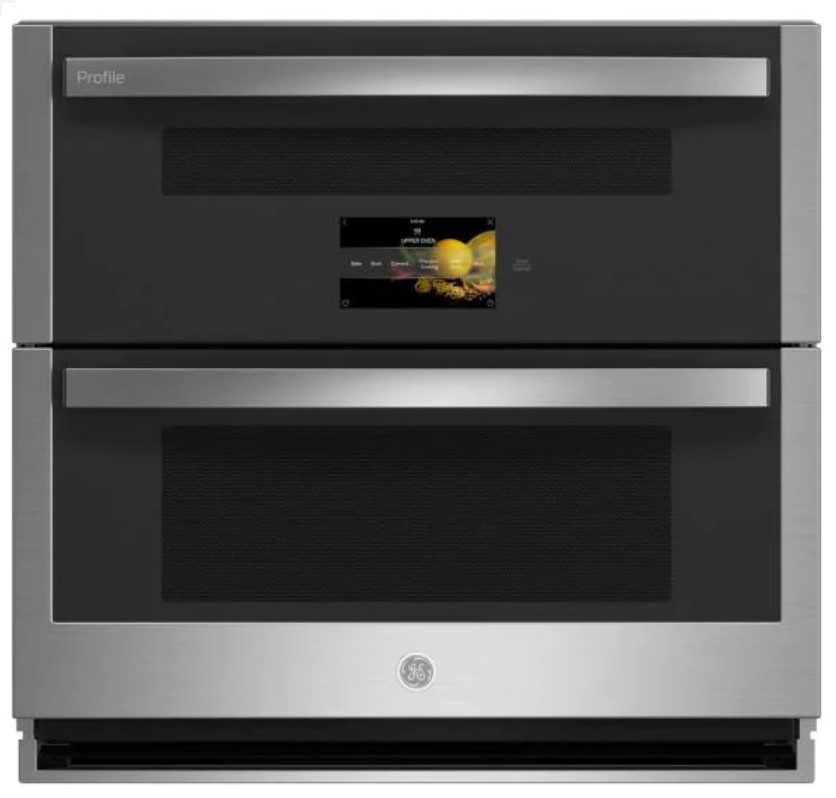
These appliances are made to be stacked so food prep is undertaken via two separate units.
Available in large capacity, fast preheating and telescoping rack models, shoppers can choose between side- or right-opening units as well as drop-down doors.
Most often crafted of stainless steel and available in 27- and 30-inch widths to fit vertical spaces, Consumer Reports testers stress the importance of getting the height right for maximal efficiency.
Double wall ovens “should be installed at a height that allows for easy access — the upper oven should be reachable, and the lower oven shouldn’t require any more bending than needed.”
11. Combination wall ovens with microwave/convection ovens
While these units are not inexpensive, homeowners seeking two popular ovens designed within a singular unit find this type of appliance to be an unbeatable combination.
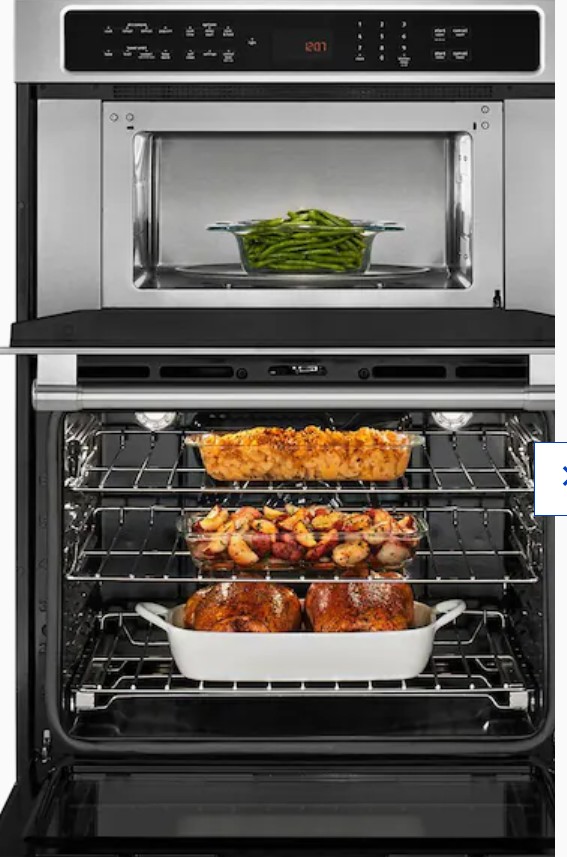
Prices are starting to drop which means that you won’t have trouble finding one that suits your budget.
Typically sold in 27- and 30-inch widths, these appliances may offer shoppers a choice of microwave or convection oven in addition to a conventional oven.
Stainless steel is standard, though finishes could be black or white instead of silver.
Categorized by how each type cooks food:
12. Convection ovens
These are fast becoming the favorite kitchen appliance for contemporary cooks because they prepare food by exposing uncooked ingredients to a fan and exhaust system that, in concert, blow hot oven air over and around items being cooked.
Vents remove that hot air and the result is food that cooks faster and more evenly.
Your reward for choosing a convection oven is evident: Food cooks about 25% faster than conventional ovens and since moisture can’t escape, foods remain moist yet meats and veggies brown easily.
You’ll save lots of energy since heat is delivered so uniformly, temperature variances are rare because heat is so efficiently circulated.
13. Conventional ovens
These are made with two heating elements installed within the cabinet so cooking and baking tasks can be accomplished by using one or the other.
While the top heating element is designed to broil foods, the bottom does the heavy lifting when preparing a recipe requiring baking.
Shifting interior racks are critical because “The dish closest to the active heating element cooks the fastest,” notes appliance manufacturer Whirlpool.
There is no interior fan to circulate air as there are in convection ovens. Owning both convection and conventional is the ideal combination – especially for cooks who alternate between fast-prepping and baking a full meal for a family supper.
Categorized by special features:
14. Smart oven/ranges with app control
Technology has become so sophisticated, even kitchen appliances are benefitting from advances, say Consumer Reports testers.
At the top of Consumer Reports recommendation list are smart stoves and ranges made by Dacor and Kohler.
Dacor smart ovens let users control all aspects of cooking via the built-in wireless tablet.
Alternately, consumers can use their own devices to control the process after downloading software that not only sends out product updates but recipes in case you can’t come up with your own!
You could part with $12,000 if nothing but a Dacor dual-fuel range will do. In return, this appliance can do just about everything but chop foods.
You can preheat remotely, lower the oven temperature from afar and control every aspect of the process going on within oven walls.
The Kohler OnCue smart appliance operates in much the same way but goes one step further: If you have a problem with oven functions, you’ll be notified by the app so you can call someone to fix it.
The app controlling the OnCue interfaces with Apple and Android systems but there’s a fee associated with this service. Both companies warn against driving and cooking!
15. Self-cleaning ovens
When this technology was introduced to the public, methodology was relatively simple.
Oven interiors with smooth enamel coatings were subjected to “the pyrolytic cleaning method” that consists of removing soil by incinerating it at temperatures averaging between 900- and 1000-degrees F.
Some self-cleaning ovens have catalytic converters that vent the remains of ash and powder.
A second type of self-cleaning oven uses steam instead of heat to do the job. Self-cleaning steam units required only low heat and steam to prepare the interior to be wiped clean in less than an hour once grime has been mediated.
A third type of self-cleaning oven is classified as Continuous cleaning. The technology behind it won’t necessarily do a thorough job of eliminating hard soil and spills.
What’s best way to clean an oven? According to John Kelly, writing for the How Stuff Works website, the answer is simple: “Keep it from getting dirty” in the first place.
Use metal trays or sheets of foil on bottom racks to contain spills. He also recommends pouring salt on fresh spills to keep that substance from hardening.
Should you use oven cleaners? No, Kelly adds! These products include lye and solvents. If you insist upon buying one of these sprays, choose one with a label that notes, “safe for self-cleaning ovens.”
Further, don’t use metal scrapers, scouring pads or wire brushes on self-cleaning ovens. You likely spent more money on your self-cleaning oven so protect your purchase and let your self-cleaning oven do its job.
Resources
https://www.oldhouseonline.com/kitchens-and-baths-articles/kitchen-appliances/history-of-the-kitchen-stove/
https://www.maytag.com/blog/kitchen/range-vs-stove-vs-oven.html
https://www.hunker.com/13409456/how-does-an-electric-stove-work
https://engineer.decorexpro.com/en/gaz/equip/kak-rabotaet-gazovaya-plita.html
https://www.cda.eu/hobs/how-does-induction-cooking-work/
https://homeguides.sfgate.com/wood-burning-stoves-work-70432.html
https://www.goodfood.com.au/good-living/home-and-design/steam-ovens-101-what-are-steam-ovens-and-how-do-they-work-20170824-gy3h8j
https://www.homeadvisor.com/r/pellet-stoves/
https://www.bosch-home.com/us/productslist/cooking-baking/wall-ovens/double-ovens
https://www.consumerreports.org/cro/wall-ovens/buying-guide/index.htm
https://www.finecooking.com/article/better-cooking-through-convection
https://www.thekitchn.com/whats-a-convection-oven-and-when-do-i-use-it-appliance-guides-from-the-kitchen-216549
https://www.whirlpool.com/blog/kitchen/convection-vs-regular-oven.html
https://www.consumerreports.org/cro/news/2014/02/you-can-control-appliances-by-smart-phone-but-is-it-wise/index.htm
https://home.howstuffworks.com/self-cleaning-ovens1.htm
https://www.consumerreports.org/cro/ranges.htm
https://home.howstuffworks.com/self-cleaning-ovens3.htm
Related Posts
- 11 Ways to Get Rid of Cooking Smells in a Small Apartment or House
- Comparison of Corian Countertops vs Laminate for Kitchens
- All About Fragranite Kitchen Sinks With Pros & Cons
- Comparison of Granite Composite Sink vs Stainless Steel
- How Much Does it Cost to Paint Kitchen Cabinets?
- What Color Granite Goes With Maple Wood Kitchen Cabinets?
Leave a Reply